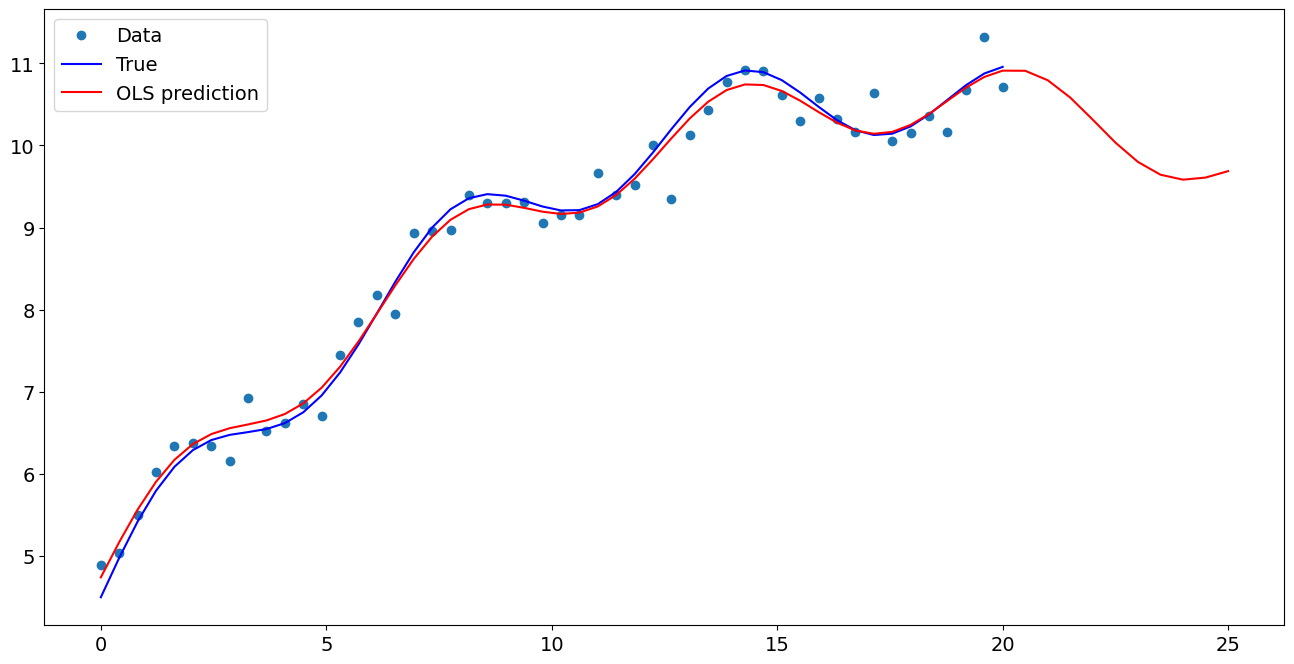Prediction (out of sample)¶
[1]:
%matplotlib inline
[2]:
import numpy as np
import matplotlib.pyplot as plt
import statsmodels.api as sm
plt.rc("figure", figsize=(16, 8))
plt.rc("font", size=14)
Artificial data¶
[3]:
nsample = 50
sig = 0.25
x1 = np.linspace(0, 20, nsample)
X = np.column_stack((x1, np.sin(x1), (x1 - 5) ** 2))
X = sm.add_constant(X)
beta = [5.0, 0.5, 0.5, -0.02]
y_true = np.dot(X, beta)
y = y_true + sig * np.random.normal(size=nsample)
Estimation¶
[4]:
olsmod = sm.OLS(y, X)
olsres = olsmod.fit()
print(olsres.summary())
OLS Regression Results
==============================================================================
Dep. Variable: y R-squared: 0.982
Model: OLS Adj. R-squared: 0.981
Method: Least Squares F-statistic: 829.7
Date: Tue, 14 May 2024 Prob (F-statistic): 4.88e-40
Time: 16:35:08 Log-Likelihood: -2.9565
No. Observations: 50 AIC: 13.91
Df Residuals: 46 BIC: 21.56
Df Model: 3
Covariance Type: nonrobust
==============================================================================
coef std err t P>|t| [0.025 0.975]
------------------------------------------------------------------------------
const 4.8221 0.091 52.861 0.000 4.638 5.006
x1 0.5225 0.014 37.139 0.000 0.494 0.551
x2 0.4788 0.055 8.658 0.000 0.368 0.590
x3 -0.0218 0.001 -17.610 0.000 -0.024 -0.019
==============================================================================
Omnibus: 4.438 Durbin-Watson: 1.907
Prob(Omnibus): 0.109 Jarque-Bera (JB): 2.026
Skew: 0.140 Prob(JB): 0.363
Kurtosis: 2.054 Cond. No. 221.
==============================================================================
Notes:
[1] Standard Errors assume that the covariance matrix of the errors is correctly specified.
In-sample prediction¶
[5]:
ypred = olsres.predict(X)
print(ypred)
[ 4.27824761 4.76674036 5.21675802 5.60220405 5.90640002 6.12482583
6.26586232 6.34941436 6.40364052 6.46032669 6.54966376 6.69528733
6.91039446 7.19557543 7.53871674 7.91699135 8.30060908 8.65771106
8.95960404 9.18547465 9.3258089 9.3839554 9.3755751 9.32606831
9.26640146 9.22801942 9.23767919 9.31305381 9.45982872 9.67076767
9.92690159 10.20064518 10.4603291 10.67540312 10.82145548 10.88422363
10.86193756 10.76561059 10.61722993 10.44614421 10.28424161 10.16071074
10.09724499 10.10447837 10.18023844 10.30990314 10.46880322 10.6262753
10.7506998 10.81469591]
Create a new sample of explanatory variables Xnew, predict and plot¶
[6]:
x1n = np.linspace(20.5, 25, 10)
Xnew = np.column_stack((x1n, np.sin(x1n), (x1n - 5) ** 2))
Xnew = sm.add_constant(Xnew)
ynewpred = olsres.predict(Xnew) # predict out of sample
print(ynewpred)
[10.7843756 10.62631283 10.35928604 10.02608886 9.6830528 9.38625528
9.17778996 9.07546071 9.06842264 9.11983727]
Plot comparison¶
[7]:
import matplotlib.pyplot as plt
fig, ax = plt.subplots()
ax.plot(x1, y, "o", label="Data")
ax.plot(x1, y_true, "b-", label="True")
ax.plot(np.hstack((x1, x1n)), np.hstack((ypred, ynewpred)), "r", label="OLS prediction")
ax.legend(loc="best")
[7]:
<matplotlib.legend.Legend at 0x7fdf090687c0>

Predicting with Formulas¶
Using formulas can make both estimation and prediction a lot easier
[8]:
from statsmodels.formula.api import ols
data = {"x1": x1, "y": y}
res = ols("y ~ x1 + np.sin(x1) + I((x1-5)**2)", data=data).fit()
We use the I to indicate use of the Identity transform. Ie., we do not want any expansion magic from using **2
[9]:
res.params
[9]:
Intercept 4.822077
x1 0.522496
np.sin(x1) 0.478843
I((x1 - 5) ** 2) -0.021753
dtype: float64
Now we only have to pass the single variable and we get the transformed right-hand side variables automatically
[10]:
res.predict(exog=dict(x1=x1n))
[10]:
0 10.784376
1 10.626313
2 10.359286
3 10.026089
4 9.683053
5 9.386255
6 9.177790
7 9.075461
8 9.068423
9 9.119837
dtype: float64
Last update:
May 14, 2024